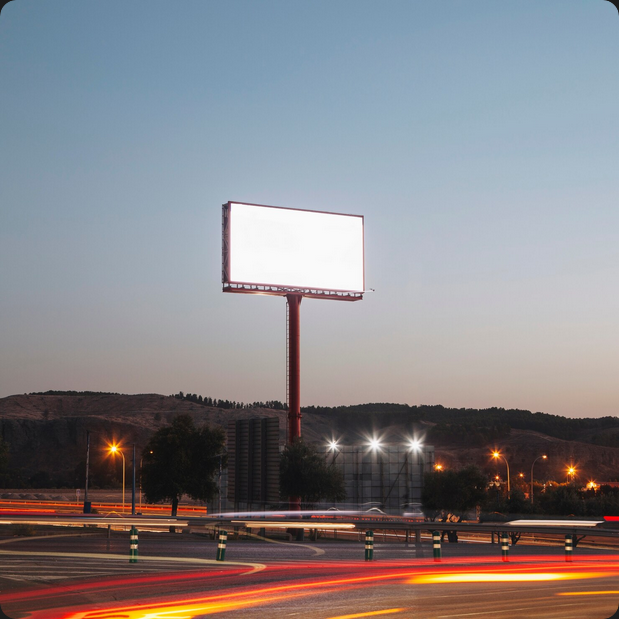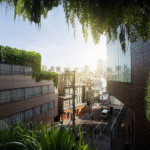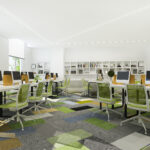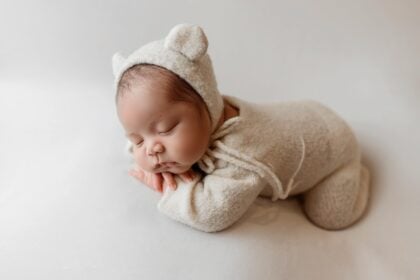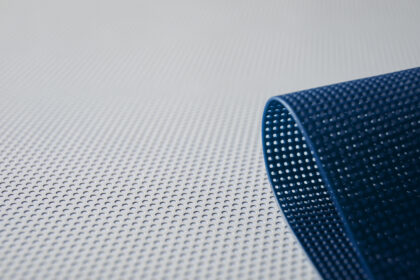Outdoor ads aren’t just seen anymore — they’re felt. Augmented reality billboards pull you into the story, turning sidewalks into stages and bystanders into participants.
The magic of AR billboards 🌟
Step into Times Square and the skyline feels alive. With augmented reality billboards, a sneaker can spring off the screen to lace itself on your foot, a coupe can splash through a virtual puddle by your toes, and a soda can mist your wrist with imagined condensation. That visceral “whoa” is the point: AR collapses the gap between message and moment, converting passive impressions into memorable micro-interactions.
Unlike static vinyl or even standard LED creative, AR layers digital objects onto the real world so the ad reacts to you — where you stand, how you move, what you look at. In a world drowning in screens, this extra sensory dimension is how out-of-home earns attention again. For a broader take on experiential tech meeting human behavior, BigTrending’s look at where technology meets human ingenuity frames why these city-scale moments stick.
“Just saw an AR billboard that made me stop in my tracks. Felt like I was in a video game! 🎮” — an X user
“These AR billboards are insane! It’s like the future is right here on our streets.” — a TikTok user
Why brands are diving in 💡
Unmatched engagement
AR turns a glance into a moment. When a display mirrors your gesture or tracks your gaze, your brain flags it as meaningful. That attention dividend is the rarest currency in advertising — and AR hoards it.
Better data (without being creepy)
Thoughtful setups use privacy-respecting interaction metrics — dwell time in a geofenced zone, aggregate gesture counts, opt-in mobile follow-ups — to show which beats make people linger. You’re not guessing what worked; you see it in behavior.
Stickier brand recall
Novelty fades, but embodied experiences — where you physically participate — leave stronger memory traces than drive-by billboards. It’s the difference between hearing a song and playing a chord. If you’re mapping the traditional side of the medium, the OOH advertising primer helps position AR within formats, buying, and measurement.
The tech that makes it feel like magic 🔧
- Cameras & sensors: Detect crowd position and simple gestures (left/right, near/far, hands up).
- Real-time rendering engines: Composite 3D assets over the live scene with proper scale and parallax.
- High-brightness LED facades: Make visuals pop at city scale, in noon sun or evening drizzle.
- Scene logic: Rules like “spawn confetti when two people raise arms” or “switch creative when a crowd forms.”
- Mobile handoffs: QR/NFC to continue the experience on your phone — try-on, coupon, or mini-game.
Under the hood, it’s still AR — computer-generated graphics anchored to the real world — just writ large. If you want the vocabulary (SLAM, occlusion, markers), skim the augmented reality overview to align teams across creative and engineering.
What success looks like (the modern OOH scorecard)
- Dwell time uplift vs. baseline creative on the same screen.
- Participation rate (gestures detected, QR scans, opt-ins).
- Post-exposure lift (brand recall, intent, nearby store footfall in 24–48 hours).
- Content flywheel (UGC volume/quality — the board becomes a destination).
Pro tip: Treat AR boards like live theater. Rotate “acts” every few minutes so walk-ups get a wow within 10–15 seconds.
Mini case snapshots (composite best practices)
Coca-Cola’s “refresh” moment
A towering bottle “uncaps,” bubbles cascade and track passersby as they wave. A QR hands off to a limited-time flavor at fridges nearby. Result: dwell spike, clean retail tie-in, and social clips that keep paying impressions.
Lexus street trial
A sedan appears to glide around pedestrians based on their positions, then invites a quick gesture mini-game about safety tech. The payoff is a dealer route map tailored to that corner — clever, useful, measurable.
Indie sneaker drop
Shoes auto-fit to silhouettes at 50 feet; pose for a split-second photo moment. A tap saves the exact colorway in a cart for pickup two blocks away. Conversion happens on the walk, not at home.
Creative that wins: a fast brief to steal
- Human hook: What will someone do naturally? (Look up, wave, pose, step closer.)
- Site fit: How does this corner breathe? (Sightlines, reflections, competing light.)
- Three beats, one story: Surprise → Interaction → Reward. Cut what isn’t one of those beats.
- Shareable pose: Bake in a 1-second frame that captures the audience in the scene — logo present but polite.
- Polite exit: A soft call to continue (QR/NFC) that hands off to mobile or nearby retail.
For marketers aligning their broader funnel with street-level spectacle, BigTrending’s mobile marketing is the future of e-commerce shows how on-phone behavior and on-street moments reinforce each other.
Production realities (so your AR doesn’t glitch on launch day)
- On-site previs: Capture a clean plate from the actual viewing cone; preview the composite before locking media.
- Lighting LUTs: Build day/dusk/night looks; auto-switch to avoid washout or neon glare.
- Occlusion maps: If a pole or canopy is in frame, model it so virtual objects pass behind convincingly.
- Latency budget: < ~120 ms is the difference between “magic” and “lag.”
- Accessibility: Caption any audio callouts; add motion-sensitivity toggles for intense sequences; cap brightness at night.
Costs, constraints, and where to save 💸
- Media buy: Premium corners (Times Square, Shinjuku, Piccadilly) = premium CPMs — you’re paying for foot traffic and camera phones.
- 3D production: Great shaders sell realism. Reuse a core rig across scenes to stretch budget.
- Sensors & compute: Flagship sites often bundle the stack; for pop-ups, modular rigs (camera + compact GPU) travel well.
- Ops: Nightly QA is not optional. Wind, rain, and city grime will stress-test your pipeline.
Where to save: Build a portable “AR kit” (hero asset + physics + gesture set) you can reskin per city and season.
Measurement and privacy (be brilliant, not creepy) 🔐
Design for aggregate, ephemeral analytics — skeletal points or blob tracking instead of facial ID — and say so on the billboard. If you want deeper data, earn opt-in via QR with a clear value trade: extra game levels, a limited drop, or a neighborhood-only perk. The Out of Home Advertising Association’s playbooks on responsible measurement are a helpful yardstick; their resources on OOH standards keep teams aligned with best practice.
Where AR OOH is heading next 🚀
- Personalization 2.0: With consent, the board recognizes returning participants (via device token, not identity) and serves the next chapter of the story.
- Connected commerce: Add the exact variant you “tried on” to your cart and pick up within the hour.
- Weather-aware creative: Seamless pivots for rain, snow, heat — message always matches the moment.
- Networked stories: A narrative that hops across the city — beat one at the subway, beat two at the plaza, finale at the flagship.
- City partnerships: Tie into cultural calendars so the board feels local, not parachuted in.
Field playbook: launch in four phases 🗺️
Phase 1 — Scout & fit
Audit pedestrian flow, angles, reflections, sun path. Pick your hero moment (vertical leap? reveal from behind a facade?) based on natural movement.
Phase 2 — Prototype in public
Pop up on a smaller screen nearby. Test gesture grammar and log real-world latency.
Phase 3 — Prime-time build
Lock the three-beat arc, polish shaders, tune audio sweeteners (low, friendly, never abrasive), and load-test at rush hour.
Phase 4 — Launch & learn
Rotate acts every two weeks, A/B your QR copy, and publish the highlights reel so the board lives online long after exposure.
Small brand? You can still play 🧰
- Piggyback a DOOH network: Many now offer AR-enabled slots at entry budgets.
- Go modular: Commission one high-quality 3D hero and design three micro-interactions you can redeploy city to city.
- Partner locally: Team up with a museum, sports team, or indie creator to earn organic amplification money can’t buy.
“Stayed for three loops without realizing it. The sidewalk became a scene. 🚀” — a TikTok user
Culture shift: the city becomes a playable medium 🎭
The headline isn’t just better ads; it’s streets becoming interactive canvases. When a place can smile back — when architecture participates — people relate to brands (and cities) differently. Done right, augmented reality billboards are polite intruders: brief, delightful, and respectful of the commons. They earn attention rather than steal it, which is why they keep ending up in camera rolls and group chats.
Want another layer on why certain innovations leap from gimmick to everyday expectation? Skim our take on where technology meets human ingenuity for the through-line that connects AR OOH to broader culture.
FAQ: Unpacking AR billboards
What makes an AR billboard different from a regular one?
Augmented reality billboards blend 3D graphics with the real environment so the ad can react to your position and movement, creating an interactive, memorable moment. For fundamentals, see the augmented reality explainer.
How do these billboards function?
They use cameras/sensors for motion tracking, real-time rendering to place digital objects convincingly, and high-brightness LED screens to display the composite. Handoffs via QR/NFC let the moment continue on mobile and into commerce.
What are the key advantages of AR billboards?
Higher engagement, richer (privacy-respecting) interaction data, and stronger brand recall. Well-designed augmented reality billboards also generate organic social sharing that multiplies reach. If you plan a media mix, the OOH advertising overview helps frame measurement.
Where can I experience them?
Major hubs like New York, Los Angeles, Tokyo, and London frequently host AR OOH activations, with brands from Coca-Cola to Lexus experimenting — and networks adding AR-ready inventory across cities.
Are AR billboards accessible and safe?
Best practice includes brightness caps at night, captioned audio cues, motion-sensitivity options, and clear privacy disclosures so delight never tips into discomfort.



